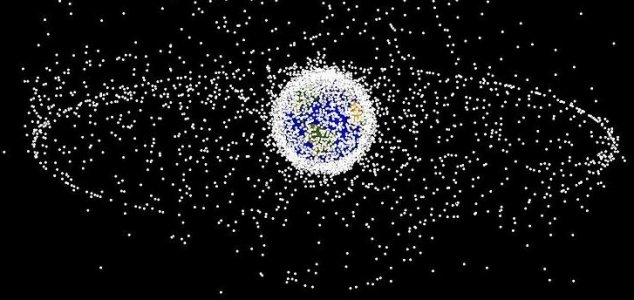Space & Astronomy
December 9, 2019 · 4 comments
4 comments

Our planet is surrounded by thousands of items of space junk. Image Credit: NASA
As things stand, there are estimated to be more than 3,500 defunct satellites and as many as 750,000 smaller fragments of debris circling far above our heads with more being added all the time.
"Imagine how dangerous sailing the high seas would be if all the ships ever lost in history were still drifting on top of the water," said ESA's director general Jan Worner.
"That is the current situation in orbit, and it cannot be allowed to continue."
Now in a renewed bid to tackle the problem, ESA is planning to launch a four-armed robotic spacecraft that will attempt to grab a single piece of debris and drag it out of orbit.
Known as ClearSpace-1, the mission will target a specific object known as Vespa which was left in orbit by ESA's Vega launcher in 2013. Once the spacecraft latches on it will drag the object back towards Earth where both will burn up in the planet's atmosphere.
While this might seem like a drop in the ocean given how much junk is up there, the endeavour will help to pave the way for more ambitious debris collection missions in the future.
Eventually, reusable rockets and satellites that de-orbit themselves once they have become defunct could help to significantly slow down the build-up of debris.
Until then however, keeping Earth's orbit clear of junk is going to be quite a challenge.
Source: The Guardian | Comments (4)
ESA to launch space debris collector in 2025
By T.K. RandallDecember 9, 2019 ·
 4 comments
4 comments
Our planet is surrounded by thousands of items of space junk. Image Credit: NASA
If successful, the mission will be the first ever to remove a piece of space junk from Earth's orbit.
Satellites and spacecraft are already running a daily gauntlet of spent rocket stages, screws, bolts and other objects that currently encircle our world. As time goes on, the problem will reach the point at which it will be too risky to send anything else up into space due to the risk of a collision.As things stand, there are estimated to be more than 3,500 defunct satellites and as many as 750,000 smaller fragments of debris circling far above our heads with more being added all the time.
"Imagine how dangerous sailing the high seas would be if all the ships ever lost in history were still drifting on top of the water," said ESA's director general Jan Worner.
"That is the current situation in orbit, and it cannot be allowed to continue."
Known as ClearSpace-1, the mission will target a specific object known as Vespa which was left in orbit by ESA's Vega launcher in 2013. Once the spacecraft latches on it will drag the object back towards Earth where both will burn up in the planet's atmosphere.
While this might seem like a drop in the ocean given how much junk is up there, the endeavour will help to pave the way for more ambitious debris collection missions in the future.
Eventually, reusable rockets and satellites that de-orbit themselves once they have become defunct could help to significantly slow down the build-up of debris.
Until then however, keeping Earth's orbit clear of junk is going to be quite a challenge.
Source: The Guardian | Comments (4)

The Unexplained Mysteries
Book of Weird News
AVAILABLE NOW
Take a walk on the weird side with this compilation of some of the weirdest stories ever to grace the pages of a newspaper.
Click here to learn more

Support us on Patreon
BONUS CONTENTFor less than the cost of a cup of coffee, you can gain access to a wide range of exclusive perks including our popular 'Lost Ghost Stories' series.
Click here to learn more
United States and the Americas
UK and Europe
Other World News
Russia and the War in Ukraine
Total Posts: 7,777,485 Topics: 325,493 Members: 203,902
Not a member yet ? Click here to join - registration is free and only takes a moment!
Not a member yet ? Click here to join - registration is free and only takes a moment!

































Please Login or Register to post a comment.